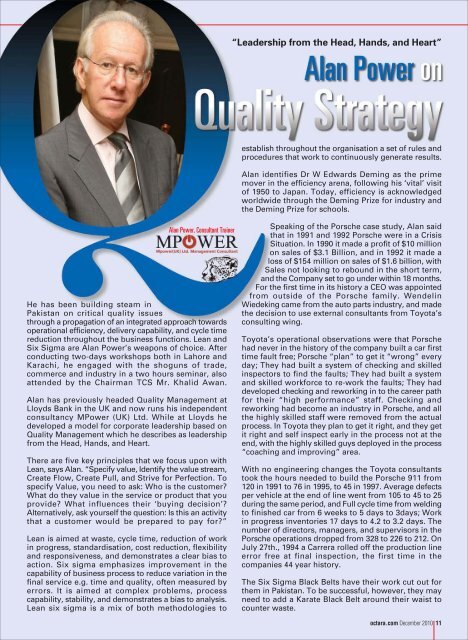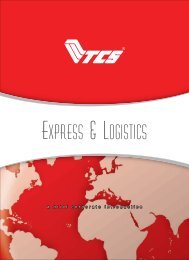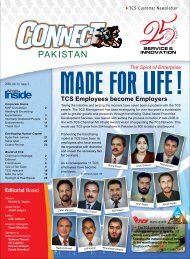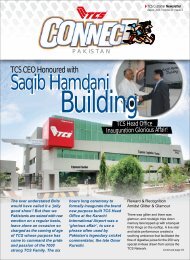PDF Version - TCS Courier
PDF Version - TCS Courier
PDF Version - TCS Courier
You also want an ePaper? Increase the reach of your titles
YUMPU automatically turns print PDFs into web optimized ePapers that Google loves.
Alan Power, Consultant Trainer<br />
He has been building steam in<br />
Pakistan on critical quality issues<br />
through a propagation of an integrated approach towards<br />
operational efficiency, delivery capability, and cycle time<br />
reduction throughout the business functions. Lean and<br />
Six Sigma are Alan Power’s weapons of choice. After<br />
conducting two-days workshops both in Lahore and<br />
Karachi, he engaged with the shoguns of trade,<br />
commerce and industry in a two hours seminar, also<br />
attended by the Chairman <strong>TCS</strong> Mr. Khalid Awan.<br />
Alan has previously headed Quality Management at<br />
Lloyds Bank in the UK and now runs his independent<br />
consultancy MPower (UK) Ltd. While at Lloyds he<br />
developed a model for corporate leadership based on<br />
Quality Management which he describes as leadership<br />
from the Head, Hands, and Heart.<br />
There are five key principles that we focus upon with<br />
Lean, says Alan. “Specify value, Identify the value stream,<br />
Create Flow, Create Pull, and Strive for Perfection. To<br />
specify Value, you need to ask: Who is the customer?<br />
What do they value in the service or product that you<br />
provide? What influences their ‘buying decision’?<br />
Alternatively, ask yourself the question: Is this an activity<br />
that a customer would be prepared to pay for?”<br />
Lean is aimed at waste, cycle time, reduction of work<br />
in progress, standardisation, cost reduction, flexibility<br />
and responsiveness, and demonstrates a clear bias to<br />
action. Six sigma emphasizes improvement in the<br />
capability of business process to reduce variation in the<br />
final service e.g. time and quality, often measured by<br />
errors. It is aimed at complex problems, process<br />
capability, stability, and demonstrates a bias to analysis.<br />
Lean six sigma is a mix of both methodologies to<br />
“Leadership from the Head, Hands, and Heart”<br />
establish throughout the organisation a set of rules and<br />
procedures that work to continuously generate results.<br />
Alan identifies Dr W Edwards Deming as the prime<br />
mover in the efficiency arena, following his ‘vital’ visit<br />
of 1950 to Japan. Today, efficiency is acknowledged<br />
worldwide through the Deming Prize for industry and<br />
the Deming Prize for schools.<br />
Speaking of the Porsche case study, Alan said<br />
that in 1991 and 1992 Porsche were in a Crisis<br />
Situation. In 1990 it made a profit of $10 million<br />
on sales of $3.1 Billion, and in 1992 it made a<br />
loss of $154 million on sales of $1.6 billion, with<br />
Sales not looking to rebound in the short term,<br />
and the Company set to go under within 18 months.<br />
For the first time in its history a CEO was appointed<br />
from outside of the Porsche family. Wendelin<br />
Wiedeking came from the auto parts industry, and made<br />
the decision to use external consultants from Toyota’s<br />
consulting wing.<br />
Toyota’s operational observations were that Porsche<br />
had never in the history of the company built a car first<br />
time fault free; Porsche “plan” to get it “wrong” every<br />
day; They had built a system of checking and skilled<br />
inspectors to find the faults; They had built a system<br />
and skilled workforce to re-work the faults; They had<br />
developed checking and reworking in to the career path<br />
for their “high performance” staff. Checking and<br />
reworking had become an industry in Porsche, and all<br />
the highly skilled staff were removed from the actual<br />
process. In Toyota they plan to get it right, and they get<br />
it right and self inspect early in the process not at the<br />
end, with the highly skilled guys deployed in the process<br />
“coaching and improving” area.<br />
With no engineering changes the Toyota consultants<br />
took the hours needed to build the Porsche 911 from<br />
120 in 1991 to 76 in 1995, to 45 in 1997. Average defects<br />
per vehicle at the end of line went from 105 to 45 to 25<br />
during the same period, and Full cycle time from welding<br />
to finished car from 6 weeks to 5 days to 3days; Work<br />
in progress inventories 17 days to 4.2 to 3.2 days. The<br />
number of directors, managers, and supervisors in the<br />
Porsche operations dropped from 328 to 226 to 212. On<br />
July 27th., 1994 a Carrera rolled off the production line<br />
error free at final inspection, the first time in the<br />
companies 44 year history.<br />
The Six Sigma Black Belts have their work cut out for<br />
them in Pakistan. To be successful, however, they may<br />
need to add a Karate Black Belt around their waist to<br />
counter waste.<br />
octara.com December 2010 11









